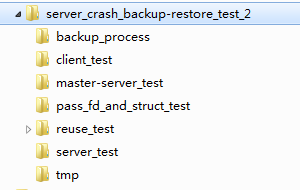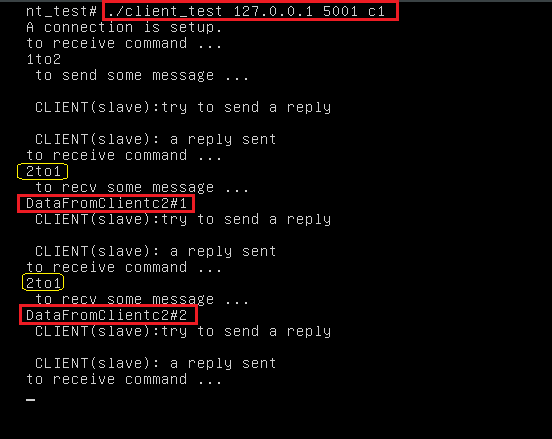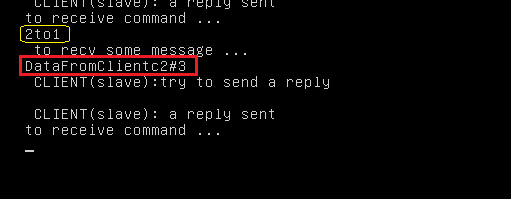Prelude:
This test code has not been cleaned up yet, :-( .
The information thatdata server backed up to backup_process is a structure including file descriptor fd, in both
server_test/ and backup_process/ there are:
Now we come to look at BACKUP and RESTORE:
Server and the Backup program
and are the same. The code is that downloaded from the web(see the URLs referenced below) with a few modifications.
Here one can refer to the unit test code for read/write under the sub-directorypass_fd_and_struct_test/ , and pass_fd_rw.c
under either server_test/ or backup_process/ .
Passing file descriptors is achieved by sendmsg/recvmsg. Some books illustrate it. And there are resources about it on the web, here some of them (in Chinese) are:
It is said there are similar mechanisms on Windows: DuplicateHandle, WSADuplicateSocket.
Besides, to let the server program be able to restart immediately, I setSO_REUSEADDR option on the socket.
The code has been tested under both Redhat 9 and Ubuntu 14. (Under Cygwin it can be compiled, but there isn't passing file description function implemented on Linux.)
Of couse, the best of all is the server program written is without any bug and will never crash. But if the idea of this article is realized, it will be a powerful tool.
I am trying to construct a web site. As a software developer, he worries about server crash most. Even
the server can be restarted, some resources get lost. This incurs one need: can there be a backup copy for recovery
of the crashed server program as same as the recovery from suffering a data loss through data backup ? I ever read
about "passing file descriptor" in Richard Stevens' Advanced Programming in the UNIX Environment. This powerful
ability, which is like 'dup/dup2', but between processes, has some meaning of generating a 'backup copy'. And this
leads me to an idea to use it to realize "process backup". Of course, it is not a process image backup, but to back
up file descriptors in a process, including the networking sockets I wish to handle.
I wrote a small program to try this idea and succeeded. Need to test it in server program for large-scale service.
I wrote a small program to try this idea and succeeded. Need to test it in server program for large-scale service.
The source code:server_crash_backup-restore_test_2.tgz for downloadThe idea of below test is: (1)Simulating two client processes "chatting"; S / \ C1 C2 (2)Conduct "process backup" for the Server; S -> B (3)Master issues an instruction and the original Server "crashes"; (4)Crash being detected, start a new process listening on the original port (e.g. websocket chatting port); (5)Get those resouces( such as fd and chatting relationship) ready for the new process; (6)To see if the two clients can continue to chat or not.
This test code has not been cleaned up yet, :-( .
After this .tgz file is uncompressed, the directory structure is as below: The directories
reuse_test/, pass_fd_and_struct_test/ can be deleted. It's better to keeptmp/ , the use of which will be seen below. Four programs are concerned:master( server), (data )server, (data )client, backup_process , each of which uses a seperate directory. We will use twodata client processes. Here it means two users(data clients) are communicating through one machine(data server) , worrying about the possible crash of the server, "back it up" to thebackup_process . Themaster is for issuing instructions. Each instruction issued will be sent to everyslave , who must select from the instructions those it needs and behave accordingly. All other programs beyond themaster areslave/client s of themaster, (data )client is the client of the(data )server. Thedata server is the client ofbackup_process . First, enter into each directory and runmake to compile. Since thebackup process and thedata server communicate through (named) UNIX domain socket here, I must specify the path, inbackup_process/client.cpp , modifyconst char* path="/usr/working3/server_crash_backup-restore_test/tmp/tmp.sock" as the one you specify. I did test on Baidu BCC and it was modified asconst char* path="/usr/working/test/server_crash_backup-restore_test_2/tmp/tmp.sock" . Do the same inserver_test/client.cpp . And then recompile. Startingmaster: (cd master-server_test ;) ./server_crash_test-master 5000 3 The parameter 3 indicates there will be 3 slaves at the very beginning, twodata client s, onedata server . Starting(data )server: (cd server_test/ ;) ./server_test 5001 Startingclients: (cd client_test;) ./client_test 127.0.0.1 5001 c1 (client no. 1) ./client_test 127.0.0.1 5001 c2 (client no. 2) Now themaster prompts in its interface it is ready for instruction input. (All the instructions are issued by themaster and the case of the letter is irrelevant.) >Input some
1to2 / 2to1 instructions (simulatingclient 1 andclient 2 are chatting). Theclient side that got the message will display the order no. of the message it received(#1,#2 ,etc.).(You may need to press the 'Enter' key to get the prompt before input the next instruction.)
Now start up the
backup process, >create It should displaybackup process started OK and that it has connected to themaster . Now themaster got one more slave.Do the backup, >
backup Then we come to look atserver crash, >crash Watch the
server interface, there should besegmentation fault (core dumped) .>
restart Restart theserver (with parameterrestart : this time thedata server do no 'accept') There should benew data server started OK . Withps command one would seeserver process re-emerges.>
restore Restores it.Input
1to2 / 2to1 instructions again under the > prompt, one would see the twoclient s can still send and receive data between them. It seems likeserver crash has never happened.
Quit from the test: >
exit
Below I illustrate the above process and instructions used in detail orderly: Start theMaster , it will have below 3slaves ; Start theServer , accept 2 connections; StartClient 1 (abbreviated asC1 )with parameterC1 , connect to theServer , theServer constructs data structure; StartClient 2 (abbreviated asC2 )with parameterC2 , connect to theServer , theServer constructs data structure;
server_test\server.cpp:
data_sock = server( service);
data_sock2 = server( service);
fd_info[0].fd = data_sock;
fd_info[0].owner = 1;
fd_info[0].target = 2;
fd_info[0].paired = 1;
fd_info[0].fd_orig = data_sock;
fd_info[1].fd = data_sock2;
fd_info[1].owner = 2;
fd_info[1].target = 1;
fd_info[1].paired = 1;
fd_info[1].fd_orig = data_sock2;
1TO2/2TO1 are for instructingServer andClient ( target of this instruction):1TO2 :Server gets ready to receive fromC1 ;C1 sends message toServer ;Server looks forC2 ;Server sends message toC2 ;C2 gets ready;C2 receives the message;2TO1 :Server gets ready to receive fromC2 ;C2 sends message toServer ;Server looks forC1 ;Server sends message toC1 ;C1 gets ready;C1 receives the message; Here it is some common socket communication code.CREATE : target of this instruction: theMaster itself; (TheMaster ) starts up theBackup process.
master-server_test\server.cpp:
if(!strcasecmp(buf, "CREATE" ))
{
int pid = fork();
......
if(pid == 0)
{
execl("../backup_process/backup_process", "backup_process", NULL);
......
}
}
BACKUP : targets of this instruction:Server process andBackup process.Server sends structure data toBackup process; (the latter processes the message) The code will be talked about later.CRASH : target of this instruction:Server .RESTART : target of this instruction: theMaster itself. (theMaster ) starts up a newServer ; (with parameter "restart": so not to enter into the code run by the oldServer that "accept"s connections)
master-server_test\server.cpp:
if(!strcasecmp(buf, "RESTART" ))
{
int pid = fork();
......
if(pid == 0)
{
......
execl("../server_test/server_test", "server_test", "2000","restart", NULL);
......
}
}
server_test\server.cpp:
if (!strcasecmp(argv[argc - 1], "restart"))
;
else
......
Passing fd only is not enough, for you cannot discern those among them. Luckily we can pass structure messages using sendmsg/recvmsg.RESTORE : targets of this instruction:Backup process and the newServer .Backup process sends structure data to the newServer ; (the latter processes the message) The code will be talked about later.1TO2/2TO1 : As the above. Continue to watch if the chat goes as normally. (One can see in the code another two instructionsCTOS/STOC , they are similar to1TO2/2TO1 and are used in the old version, here they are irrelevant.)
The information that
pass_fd_struct_rw.h
typedef struct{
SOCKET fd; //socket fd
int owner; //client id
int target; //chating peer
int paired; //is it a chat pair?
int fd_orig; //some original information
}fd_s;
extern fd_s fd_info[2];
Now we come to look at BACKUP and RESTORE:
(data )Server side:BACKUP :
server_test\client.cpp:
if(!strcasecmp(buf, "BACKUP"))
{
......
int ret = to_backup(data_sock );
if(ret < 0)
printf("backup 1 error!\n");
sleep(3);
ret = 0;
ret = to_backup(data_sock2);
if(ret < 0)
printf("backup 2 error!\n");
}
server_test\client.cpp:
Backup process side:
int to_backup(SOCKET fd_to_backup)
{
......
ret = write_fd_struct(sockfd, (fd_to_backup == fd_info[0].fd)? &fd_info[0] : &fd_info[1] , \
sizeof(fd_s) );
......
}
backup_process\client.cpp:
if(!strcasecmp(buf, "BACKUP"))
{
......
for(int i = 0; i < 2; i++)
{
int ret = do_backup();
if(ret < 0)
fprintf(stderr, "do_backup() %d return FAIL.\n", i+1);
else
printf("got passed fd seems OK.\n");
if(i == 0)
fd_backup = ret;
else
fd_backup2 = ret;
}
}
backup_process\client.cpp:
The two functions for read/write are implemented in pass_fd_struct_rw.cpp. They lie in both the
SOCKET do_backup()
{
......
static int count = 0;
ret = read_fd_struct(fdaccept, &fd_info[count], sizeof(fd_s));
++count;
......
return ret;
}
Here one can refer to the unit test code for read/write under the sub-directory
pass_fd_struct_rw.cpp:
#include "pass_fd_struct_rw.h"
int write_fd_struct(int sock, fd_s* data, int size)
{
msghdr msg;
// init msg_control
if(data->fd == -1){
msg.msg_control = NULL;
msg.msg_controllen = 0;
}
else{
union {
struct cmsghdr cm;
char space[CMSG_SPACE(sizeof(int))];
} cmsg;
memset(&cmsg, 0, sizeof(cmsg));
cmsg.cm.cmsg_level = SOL_SOCKET;
cmsg.cm.cmsg_type = SCM_RIGHTS; // we are sending fd.
cmsg.cm.cmsg_len = CMSG_LEN(sizeof(int));
msg.msg_control = (cmsghdr*)&cmsg;
msg.msg_controllen = sizeof(cmsg);
*(int *)CMSG_DATA(&cmsg.cm) = data->fd;
}
// init msg_iov
iovec iov[1];
iov[0].iov_base = data;
iov[0].iov_len = size;
msg.msg_iov = iov;
msg.msg_iovlen = 1;
// init msg_name
msg.msg_name = NULL;
msg.msg_namelen = 0;
if (sendmsg(sock, &msg, 0) == -1){
cout << "[write_fd_struct] sendmsg error" << endl;
return (-1);
}
return 0;
}
int read_fd_struct(int sock, fd_s* data, int size)
{
msghdr msg;
// msg_iov
iovec iov[1];
iov[0].iov_base = data;
iov[0].iov_len = size;
msg.msg_iov = iov;
msg.msg_iovlen = 1;
// msg_name
msg.msg_name = NULL;
msg.msg_namelen = 0;
// msg_control
union { // union to create a 8B aligned memory.
struct cmsghdr cm; // 16B = 8+4+4
char space[CMSG_SPACE(sizeof(int))]; // 24B = 16+4+4
} cmsg;
memset(&cmsg, 0, sizeof(cmsg));
msg.msg_control = (cmsghdr*)&cmsg;
msg.msg_controllen = sizeof(cmsg);
if (recvmsg(sock, &msg, 0) == -1) {
cout << "[read_fd_struct] recvmsg error" << endl;
return (-1);
}
#if 1
printf( "recvmsg() ends, data is: fd:%d\n", data->fd);
#endif
data->fd = *(int *)CMSG_DATA(&cmsg.cm);
//int fd = *(int *)CMSG_DATA(&cmsg.cm);
#if 1
printf( "recvmsg() ends, after pass, fd turns to:%d, different?\n", data->fd);
#endif
return data->fd;
//return fd;
}
Backup process side:RESTORE :reversing the read/write direction ofBACKUP .
backup_process\client.cpp:
if(!strcasecmp(buf, "RESTORE"))
{
......
int ret = do_restore(fd_backup2);
if(ret < 0)
fprintf(stderr, "do_restore() II return FAIL.\n");
ret = do_restore(fd_backup);
if(ret < 0)
fprintf(stderr, "do_restore() I return FAIL.\n");
}
backup_process\client.cpp:
(data )Server side:
int do_restore(SOCKET fd)
{
......
ret = write_fd_struct(fdaccept, (fd == fd_info[0].fd)? &fd_info[0] : &fd_info[1] , \
sizeof(fd_s) );
......
}
server_test\client.cpp:
if(!strcasecmp(buf, "RESTORE"))
{
......
for(int i = 0; i < 2; i++)
{
sleep(3);
int fd_restore = to_restore();
if(fd_restore < 0)
fprintf(stderr, "to_restore() return FAIL.\n");
}
data_sock = fd_info[0].owner == 1 ? fd_info[0].fd : fd_info[1].fd ;
data_sock2 = fd_info[0].owner == 2 ? fd_info[0].fd : fd_info[1].fd ;
*p_data_sock[0] = data_sock ;
*p_data_sock[1] = data_sock2;
}
server_test\client.cpp:
int to_restore()
{
......
static int count = 0;
ret = read_fd_struct(sockfd, &fd_info[count], sizeof(fd_s));
++count;
......
return ret;
}
Passing file descriptors is achieved by sendmsg/recvmsg. Some books illustrate it. And there are resources about it on the web, here some of them (in Chinese) are:
(How to pass file descriptors between processes)
(Passing file descriptors in advanced inter-process communication)
(Passing file descriptors between processes: unit one)
(Passing file descriptors between processes: unit two)
(Passing file descriptors between processes: unit three)
(Passing file descriptors between processes) Or
Here
(Passing file descriptors between processes using Unix domain socket)
The book Advanced Programming in the Unix Environment illustrated it. The third volume of TCP/IP Illustrated analyzed its implementation.
The book Unix Network Programming volume 1 also talked about it. Other books also exist. Such as Linux Network Programming( in Chinese )by
Jing-Bin Song, Linux Socket Programming By Example by Warren Gay( which also got a Chinese version) and Linux Advanced Programming(in Chinese)
by Zong-De Yang.
It is said there are similar mechanisms on Windows: DuplicateHandle, WSADuplicateSocket.
Besides, to let the server program be able to restart immediately, I set
server_test\server.cpp
int opt_val = 1;
setsockopt(s, SOL_SOCKET, SO_REUSEADDR, &opt_val, sizeof(opt_val));
The code has been tested under both Redhat 9 and Ubuntu 14. (Under Cygwin it can be compiled, but there isn't passing file description function implemented on Linux.)
Of couse, the best of all is the server program written is without any bug and will never crash. But if the idea of this article is realized, it will be a powerful tool.